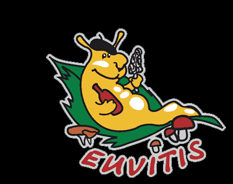 |
| |
|
|
|
 |
 |
Description: Craterellus cornucopioides. The Cornucopia, in Greek mythology, referred to the magnificent horn of the goat (or goat of the nymph) Amalthea, that filled itself with whatever meat or drink its owner requested. It has become the symbol of plenty.
Season: November, December, January, February, March |
|
| |
 |
|
| |
|
|
|
 |
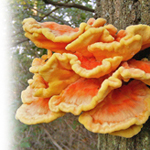 |
Description: Laetiporus. Individual "shelves" range from 2-10 inches across. These shelves are made up of many tiny tubular filaments (hyphae). The mushroom grows in large brackets - some have been found that weigh over 100 pounds (45 kg). It is most commonly found on wounds of trees, mostly oak, though it is also frequently found on yew, cherry wood, sweet chestnut, and willow. Laetiporus species produce brown rot in the host on which they grow.
Season: September, October, November |
|
| |
 |
|
| |
|
|
|
 |
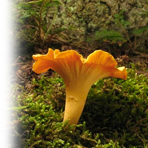 |
Description: Cantharellus cibarius. It is probably the best known species of the genus Cantharellus, if not the entire family of Cantharellaceae. It is orange or yellow, meaty and funnel-shaped. On the lower surface, underneath the smooth cap, it has gill-like ridges that run almost all the way down its stipe, which tapers down seamlessly from the cap. It has a fruity smell, reminiscent of apricots and a mildly peppery taste (hence its German name, Pfifferling).
Season: January, February, August, September, October, November, December |
|
| |
 |
|
| |
|
|
|
 |
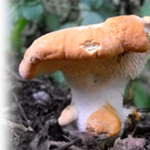 |
Description: Hydnum repandum. The orange-, yellow- or tan-colored pileus (cap) is up to 6 inches wide and generally somewhat irregular in shape (it may be convex or concave at maturity). The underside is covered with small white spines reminiscent of those of a hedgehog.
Season: January, February, March, November, December |
|
| |
 |
|
| |
|
|
|
 |
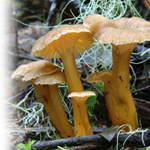 |
Description: Craterellus tubaeformis. It is smaller than the golden chanterelle and has a dark brown cap with paler gills and a hollow yellow stem. C. tubaeformis tastes stronger but less fruity than the golden chanterelle. It has a very distinctive smokey, peppery taste when raw.
Season: January, February, March, November, December |
|
| |
 |
|
| |
|
|
|
 |
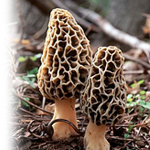 |
Description: Morchella. Genus Morchella is derived from morchel, an old German word for mushroom, while morel itself is derived from the Latin maurus meaning brown. Morels are a feature of many cuisines, including Provençal. Their unique flavor is prized by cooks worldwide, with recipes and preparation methods designed to highlight and preserve it.
Season: March, April, May, June |
|
| |
 |
|
| |
|
|
|
 |
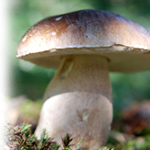 |
Description: Boletus edulis. The fungus grows in deciduous and coniferous forests and tree plantations, forming symbiotic ectomycorrhizal associations with living trees by enveloping sheaths of fungal tissue around their underground roots. Prized as an ingredient in various foods, B. edulis is an edible mushroom held in high regard in many cuisines, and is commonly prepared and eaten in soups, pasta, or risotto.
Season: April, May, June, September, October, November |
|
| |
 |
|
| |
|
|
|
 |
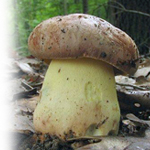 |
Description: Boletus appendiculatus. The butter bolete is distinguished by a cream to yellow-brown cap often suffused with rusty-brown to reddish-brown tints, yellowish pores that readily blue and a hardwood habitat. Unfortunately it is seldom found in quantity.
Season: May, June, September, October |
|
| |
 |
|
| |
|
|
|
 |
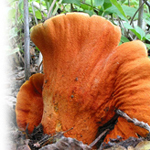 |
Description: Hypomyces lactifluorum. The Lobster mushroom is not a mushroom, but rather a parasitic ascomycete that grows on mushrooms, turning them a reddish orange color that resembles the outer shell of a cooked lobster. It has a seafood-like flavor and a firm, dense texture. According to some, they may taste somewhat spicy if the host mushroom is an acrid Lactarius.
Season: July, August, September, October |
|
| |
 |
|
| |
|
|
|
 |
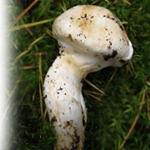 |
Description: Tricholoma matsutake. The Matsutake's scent is very spicy, sweet and clean. It has a heavy white or brown meaty flesh with a thick cotton-like partial veil. The surface is dry and smooth, with a short and broad stem. The stem and the cap develop rusty stains where they're bruised as they age. It is the odor that identifies this mushroom.
Season: August, September, October, November, December |
|
| |
 |
|
| |
|
|
|
 |
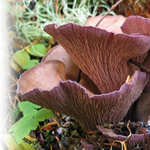 |
Description: Polyozellus. The pig's ear is a genus of fungi in the Thelephoraceae family, a grouping of mushrooms known collectively as the leathery earthfans. The distinctive fruit body of this species resembles blue- to purple-colored clusters of vase- or spoon-shaped caps with veiny wrinkles on the undersurface that run down the length of the stem.
Season: January, November, December |
|
| |
 |
|
| |
|
|
|
 |
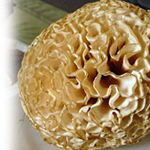 |
Description: Sparassis. The cauliflower mushroom can be very tasty. Their color can range from light brown-yellow to yellow-grey or a creamy white cauliflower color. They are normally 10 to 25 cm tall, but can grow to be quite large, with reported cases of fruiting bodies more than half a meter tall and 14 kg in weight. Experiments suggest that Sparassis contains chemicals which may stimulate the immune system and have anti-tumor properties.
Season: October, November, December |
|
| |
 |
|
| |
|
|
|
 |
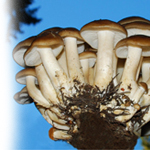 |
Description: The fried chicken mushroom, actually a wild hon-shimeji, produces a smooth surface and varies from a dark brown to a watery tan. The cap is three to twelve centimeters wide and stands about three to twelve centimeters tall. The flesh is firm and white and has little odor. Despite its name, this mushroom does not taste like fried chicken but it does offer a mild flavor and a delectable crunchy, chewy texture.
Season: October, November |
|
| |
 |
|
| |
|
|
|
 |
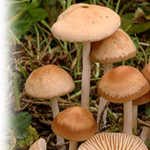 |
Description: Marasmius oreades. Mousseron is also known as Fairy ring mushrooms or Scotch Bonnett Mousseron mushrooms. Mousseron mushrooms have a fine, full-bodied almost aniseed flavor with a soft and chewy, fleshy texture like Boletes. The aroma and distinctive taste of the delicious Mousseron is reminiscent of Porcini mushrooms, almost nutty, toasty, with a slightly bitter almond edge.
Season: June, July |
|
| |
 |
|
| |
|
|
|
 |
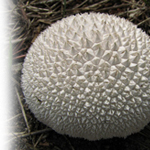 |
Description: Calvatia gigantea. The meat of puffballs tastes very similar to tofu or melted cheese when cooked.
Season: April, May, June |
|
| |
 |
|
| |
|
|
|
 |
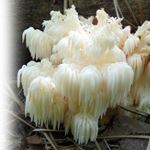 |
Description: Hericium americanum. These delicious fleshy fungi are among the most unmistakable of all of North America's species of edible wild mushrooms. Wonderful and rich flavors, taste is very "seafoody," reminiscent of lobster.
Season: October, November, December |
|
| |
 |
|
| |
|
|
|
 |
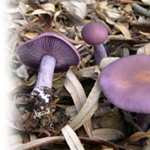 |
Description: Psilocybe caerulipes. The bluefoot mushroom (pied bleu in French) has a stem with a brilliant blue hue. Woodsy, earthy flavor and firm though delicate texture, often described as velvety.
Season: July, August |
|
| |
 |
|
| |
|
|
|
 |
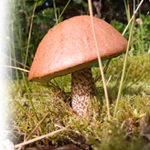 |
Description: Leccinum aurantiacum. This is a favorite species for eating and can be prepared as other edible boletes. Its flesh turns very dark on cooking.
Season: April, May, June, September, October, November, December |
|
| |
 |
|
| |
|
|
|
 |
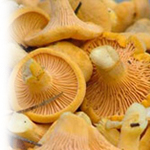 |
Description: These are small, almost perfect shaped chanterelles from the forests of Saskatchewan, Canada.
Season: August, September |
|
| |
 |
|
| |
 |
